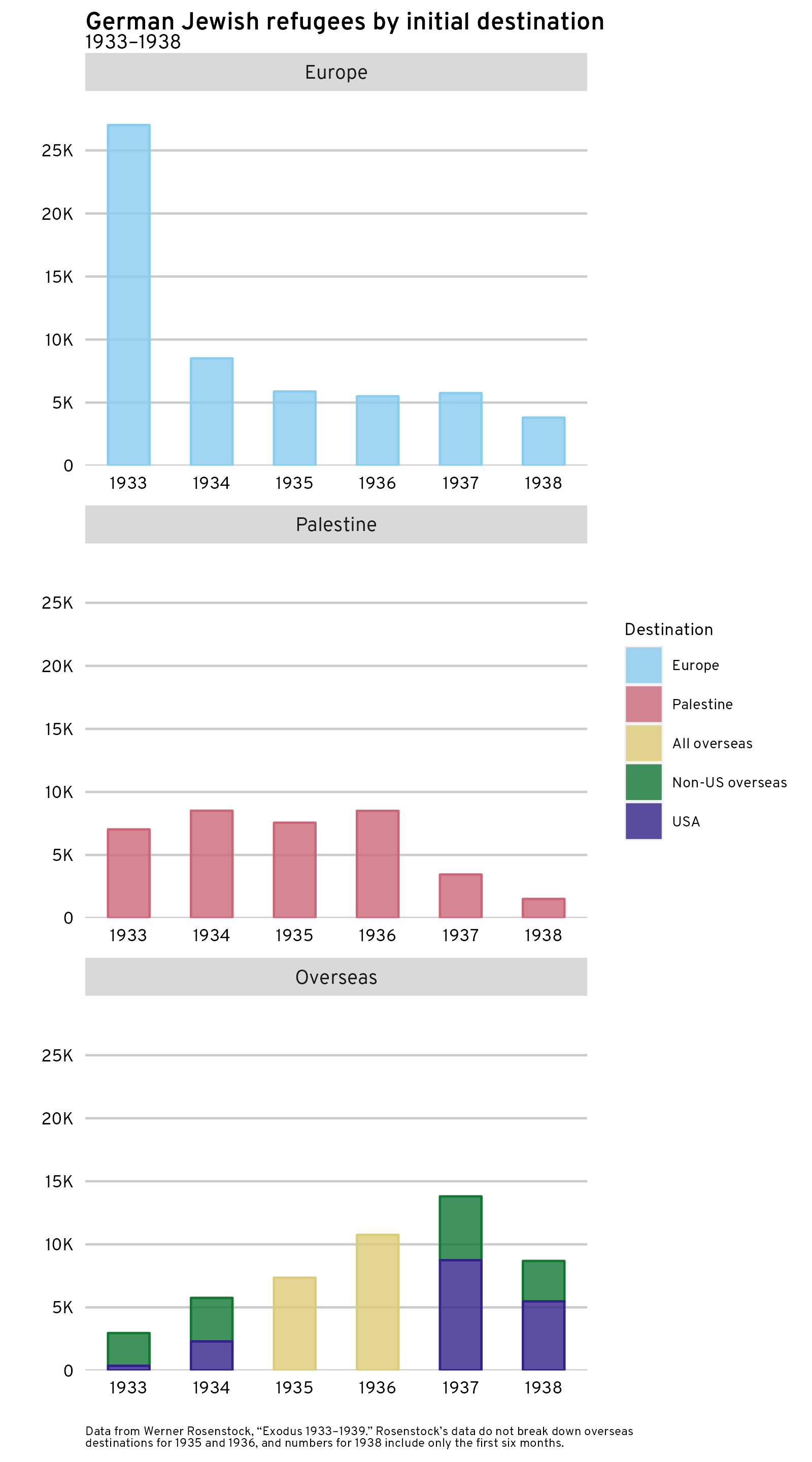
So far as I can tell the best source of data on the number and direction of German Jews fleeing the Nazi regime remains Werner Rosenstock’s 1956 article, “Exodus, 1933–1939,” which has been reprinted a number of times including in the Nazi Holocaust collection and still sees citation in books on the subject.1 Rosenstock himself noted that his figures were estimates only, and partial at that, though he did his best to check them against other source and ensure they provided at least an approximately accurate picture of trends and volumes. To make the graph at right I’ve had to do a little arithmetic to draw numbers out of Rosenstock’s article; he preferred to report propotions, probably to avoid a spurious precision—I say all that by way of trying to avoid a charge of making it appear more sure than it is.
Even so, I think it’s useful to attempt a graphical representation of the trends, because it allows us to see a few things that Rosenstock indicates in his article. First, that those who left Nazi Germany preferred hopefully to believe that they would not have to go far; that the madness would burn itself out and they could return home. So you see that other European countries were the initial first choice of those who fled Hitler’s regime.
Second, you can see that Palestine was the next-most popular choice—though it peaked in popularity early, in 1934, and in 1936, refugees were more likely to head for overseas destinations than for Palestine, perhaps because of the Arab uprising that began that year and which included attacks on Jewish settlements.
And last, you can see the increasing importance of the United States as a destination for Jewish refugees. (Note by the way that all the figures for 1938 include only half the year.) Although Rosenstock doesn’t disaggregate figures to overseas destinations for 1935 and 1936, one can suppose that the United States took a large amount of the refugees heading across oceans in those years as well.
Further, as Rosenstock notes, many of the refugees who first headed to European countries later sought destinations elsewhere.
For many, residence in these countries was to be only temporary. The difficulties both in the administrative sphere (residence and labour permits) and in the economic field often made absorption impossible and resulted in re-emigration. In retrospect, those ‘unfortunate’ re-emigrants who could not strike roots in their country of sojourn were more fortunate than their fellow-refugees who stayed behind and fell victims to the invading Nazis during the war.2
Eventually, by 1938, the global disposition of the approximately 107,000 German Jewish refugees who found their way overseas looked something like the below, according to what Rosenstock describes as “semi-official” figures.3

Footnotes
Werner Rosenstock, “Exodus 1933--1939: A Survey of Jewish Emigration from Germany,” in Bystanders to the Holocaust, ed. Michael R. Marrus, vol. 1, The Nazi Holocaust: Historical Articles on the Destruction of European Jews 8 (Westport, CT: Meckler, 1989), 143--160; Deborah Dwork and Robert Jan Pelt, Flight from the Reich: Refugee Jews, 1933--1946 (New York: W.W. Norton & Company, 2009).↩︎
Rosenstock, “Exodus 1933--1939,” 150.↩︎
Rosenstock, “Exodus 1933--1939,” 157.↩︎